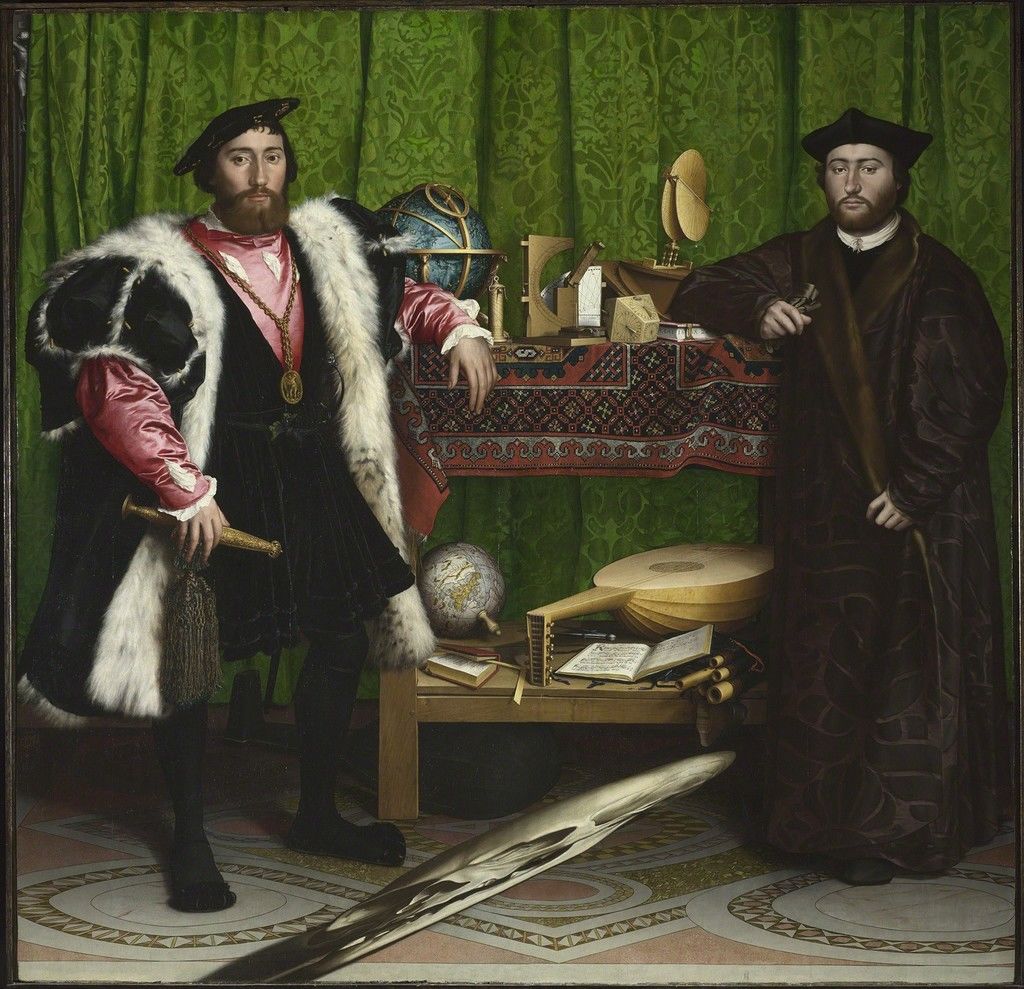
Mark A. Murphy
The Ambassadors
I am the most melancholy, weary and wearisome ambassador
in the world. — Jean de Dinteville, 1533
‘O wretched mortals,
open your eyes…’
So pleaded Leonardo,
one time for every day.
*
(XLIX)
Of course, the verdant floral
curtain
deserves another look,
dominating the backdrop. So we step
into Holbein’s puzzling
oil on oak,
painted in the old Flemish School style.
Not only a full length double portrait,
but a meticulously rendered
still life.
An anamorphic mystery,
and rendezvous with death, or memento mori.
A repository of secrets,
and morality tale
memorialising the two childhood friends
and diplomats,
Jean de Dinteville, on the left,
and Georges de Selve, (Bishop of Lavaur)
on the right, posed
amid the chaotic curios of the day,
showcasing two immaculately conceived globes:
One celestial, shows the mythological
constellations
where Cygnus the swan faces the viewer.
One terrestrial, shows Rome
at the geographical centre of the world.
On the higher shelf, we are witness
to a mare’s nest
of astrological and astronomical instruments,
intellectual/revival objet d’art
represented
by the cylindrical shepherd’s dial, a quadrant,
a torquetum,
and a polyhedral sundial.
All devices, for the revelation
of time and cosmos, and still, we are not sure
of the time of day.
Then, on the shelf below,
worldly concerns: A mathematics book
open at the page on division,
one Lutheran Hymnal, one compass,
one set-square,
one lute with a snapped string
and five bundled flutes,
all clues to the pursuits of man. Lower still,
under the bottom shelf,
a discarded lute in full shadow
turned upside down, another signifier
of the earthly life.
*
Have we missed anything, Hans?
— Of course, we have
missed de Dinteville’s
golden ceremonial scabbard,
and gold medallion
featuring the Arch-angel, St Michael,
‘defender of the church,’ killing
the serpent with his spear.
*
In this arcane panel, heaven and earth vie
for our attention.
Even the Cosmati floor
tiled mosaic
with its geometric motifs and Star
of David, boasts
of its ancestry, placing
the two Renaissance men at the centre
of the cosmos.
Now de Selve’s gloves are off
in the battle
between the faiths. He looks suspiciously
at the painter, almost squinting to see
which way he might fall
in the antagonism between King, Emperor and the Holy See.
*
We might conclude, a religious man,
however defensive
in his long damask robe and cleric’s biretta
(like the closed book
he leans on
with his right elbow)
might well have more secrets than the French
Ambassador to England,
who dares us to guess his thoughts
in his salmon satin shirt,
and expensive silk gown lined with lynx fur;
his outfit for the coronation
of Ann Boleyn. Poor (devout) Catherine
of Aragon, ‘humble
and loyal,’ soon to be divorced.
*
What else will we remember of this
Good Friday portrayal
of two young noblemen, landlord
and churchman,
the last entreaty before the great schism
with Rome
putting a brave face on it?
*
At last, in the top left corner of the painting,
we find the last piece
of the puzzle
half concealed
by the closeted green curtain —
the crucified Christ,
God’s gift
to man, awaiting
all believers
in the one true faith, despite the April freeze.
